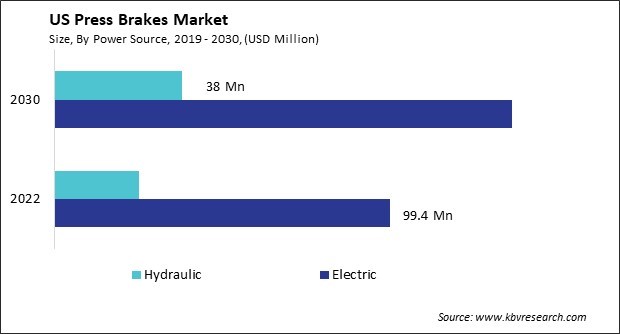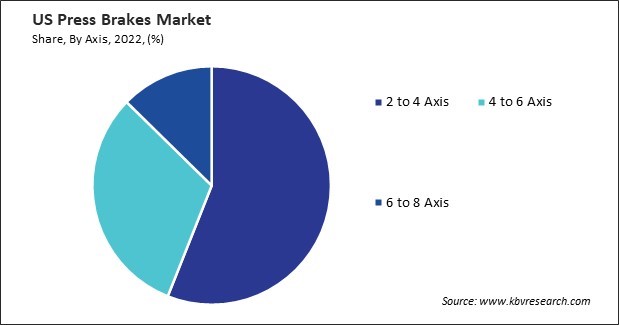The US Press Brakes Market size is expected to reach $1.7 billion by 2030, rising at a market growth of 4.4% CAGR during the forecast period.
The press brakes market in the United States is a vital component of the manufacturing sector, playing a crucial role in shaping various industries' productivity and efficiency. One of the primary drivers fueling the press brakes market's growth is the thriving manufacturing industry in the United States. According to the National Institutes of Standards and Technology, in 2022, the manufacturing sector played a significant role in the U.S. economy, contributing $2.3 trillion, which accounted for 11.4% of the total U.S. As manufacturers constantly seek to enhance their production capabilities and meet evolving consumer demands, the demand for advanced press brake technologies continues to surge.

Moreover, technological innovations have revolutionized press brake manufacturing, developing highly efficient and precise machines. Modern press brakes are equipped with features such as CNC (Computer Numerical Control) systems, hydraulic or electric drives, and advanced tooling options, enabling operators to achieve intricate bending operations with utmost accuracy and repeatability. This has significantly boosted productivity while reducing downtime and material wastage, thereby driving the adoption of press brakes across diverse industrial applications in the U.S.
Furthermore, the emphasis on automation and Industry 4.0 initiatives has propelled the integration of press brakes into smart manufacturing environments. Automation technologies such as robotic arms and IoT (Internet of Things) connectivity enable seamless integration of press brakes into automated production lines, optimizing workflow efficiency and ensuring consistent quality standards. As manufacturers increasingly embrace digitalization and automation to enhance operational efficiency and competitiveness, the demand for advanced press brake solutions will witness robust growth in the coming years.
The COVID-19 pandemic significantly impacted the press brakes market in the United States, disrupting supply chains, delaying projects, and causing uncertainty across industries. The pandemic-induced lockdowns and restrictions led to temporary closures of manufacturing facilities and construction sites, resulting in a decline in demand for press brakes and related equipment. Additionally, supply chain disruptions, including raw material shortages and logistics challenges, hindered the production and delivery of press brake machinery.
The construction industry in the United States has been a major driver of growth in the press brakes market. Press brakes are crucial in fabricating metal components and structures, making them indispensable in construction projects ranging from buildings to infrastructure. The growth of the construction industry has directly influenced the demand for press brakes in the U.S. Technological advancements in the U.S. have revolutionized the construction industry, enhancing efficiency and precision in metal fabrication processes. Modern press brakes have automation features, CNC controls, and advanced software integration, enabling manufacturers to produce complex components with greater accuracy and speed.
One significant factor contributing to the growth of the construction industry is the robust economy. The construction industry in the U.S. has experienced steady growth over the past decade, driven by population growth, urbanization, infrastructure development, and commercial and residential construction projects. According to the U.S. Census Bureau, the total value of construction put in place in the U.S. reached over $1.3 trillion in 2022, showcasing the industry's robustness. With the construction sector poised for continued expansion, fueled by urbanization trends and infrastructure renewal initiatives, the press brakes market is poised for sustained growth.
Furthermore, sustainable construction practices have emerged as a key trend, prompting developers to seek environmentally friendly building materials and methods. Metal fabrication processes using press brakes contribute to sustainability objectives by optimizing material usage and minimizing waste. Therefore, the growth of the construction industry and advancements in technology and a focus on sustainability, are driving sustained growth in the press brakes market in the United States.
The press brakes market in the United States is experiencing a notable surge in demand for customization and flexibility, driven by evolving industry needs and technological advancements. One of the primary drivers behind this trend is the increasing complexity of metal fabrication projects. As U.S. manufacturers strive to differentiate their products and meet unique customer demands, customized press brake solutions become imperative.
Another significant factor contributing to the demand for customization is the diverse nature of the end-user industries served by press brakes. From automotive and aerospace to construction and electronics, each sector has unique requirements regarding material types, thicknesses, and geometries. Customizable press brakes allow U.S. manufacturers to adapt quickly to changing industry dynamics and produce a wide range of components with precision and consistency.
Moreover, the rise of Industry 4.0 and smart manufacturing practices foster the demand for flexible press brakes equipped with advanced digital technologies in the U.S. These technologies enable seamless integration with other production systems, real-time machine performance monitoring, and predictive maintenance capabilities, enhancing overall operational efficiency and productivity. Hence, the surge in demand for customization and flexibility in the United States press brakes market is driven by evolving industry needs, diverse end-user requirements, and the integration of advanced digital technologies.

The press brakes market in the United States is a crucial component of the manufacturing sector, providing essential machinery for bending and shaping sheet metal in various industries. This industry encompasses a range of companies, from small-scale manufacturers to large corporations, each competing to offer innovative solutions and meet the diverse needs of customers across different sectors. One prominent player in the U.S. press brakes market is Cincinnati Incorporated, a company with a long history dating back to the late 19th century. Cincinnati Incorporated is renowned for its cutting-edge press brake technology, including hydraulic and hybrid press brakes and automation solutions. The company's commitment to research and development has enabled it to stay at the forefront of the industry, continually introducing new features and improving efficiency.
Amada America is also a significant player in the U.S. press brakes market, offering a comprehensive range of press brake systems, including hydraulic, electric, and hybrid models. The company's press brakes are designed for versatility and accuracy, incorporating features like dynamic crowning and intuitive control interfaces. Amada's focus on customer satisfaction and technological innovation has solidified its position as a leading provider of press brake solutions in the United States.
Another key player in the U.S. press brakes market is Trumpf, a global leader in machine tools and laser technology. Trumpf's press brakes are known for their precision, reliability, and advanced automation capabilities. With a strong presence in the United States, Trumpf caters to various industries, including automotive, aerospace, and electronics, providing tailored solutions to meet specific manufacturing requirements.
Other notable companies in the U.S. press brakes market include Bystronic, Accurpress, and Durma USA. Bystronic specializes in high-performance press brakes equipped with state-of-the-art bending technology, catering to the demands of various industries, including construction, energy, and transportation. Accurpress offers a diverse range of press brake models, from entry-level machines to large-scale production systems, providing flexibility and efficiency to manufacturers of all sizes. Durma USA, the North American division of Durma, delivers cost-effective press brake solutions with robust construction and user-friendly features, serving a broad customer base in the United States.
The U.S. press brakes market is highly competitive, with companies vying for industry share through product differentiation, technological innovation, and superior customer service. In addition to traditional press brake manufacturers, there is a growing presence of automation and robotics companies that offer solutions to enhance the efficiency and productivity of press brake operations. These developments underscore the dynamic nature of the industry and the ongoing efforts of companies to meet the evolving needs of the manufacturing industry.
By Power Source
By Axis
By Product Type
Our team of dedicated experts can provide you with attractive expansion opportunities for your business.

